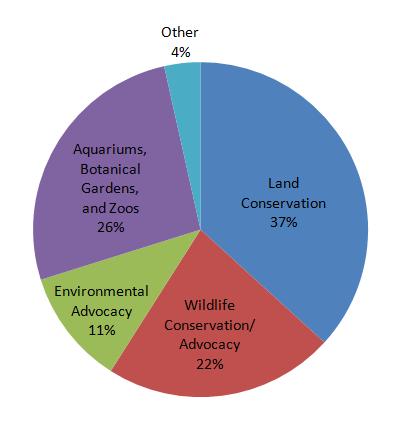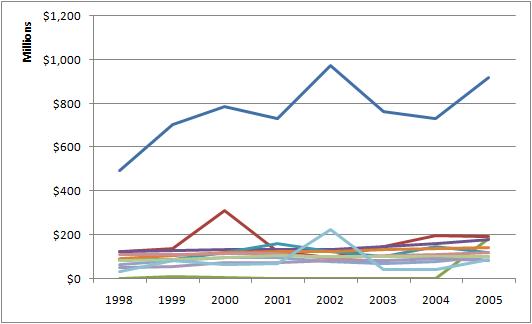Conservation Nonprofit Revenue
July 3rd, 2008Posted by: admin
This past week, I aggregated IRS tax data for the top 50 revenue producing conservation nonprofit organizations. I documented over $22.5 billion dollars in combined revenue between 1998 and 2005. The combined assets of these organizations were approximately $8 billion in 2005. To help understand where revenue is flowing, I used a simple classification system. The following pie chart breaks down revenue by sector for the eight year period:

Of little surprise, The Nature Conservancy (TNC) is the top revenue generating conservation nonprofit. In 2005, TNC accounted for 25.6% of the revenue generated by the top 50 organizations. I compare the revenue streams of the top 10 in the following graph. TNC is the dark blue line.

The distribution of financial resources can give insight into conservation priorities. Does the allocation of conservation dollars over the eight year per period align with the conservation challenges we face? Are there nonprofit sectors over or under attended to? What does the division of revenue tell us about donors? About nonprofits? About the costs of various nonprofit activities?
July 5th, 2008 at 7:21 am
I think you are trying to read too much into the data. Ultimately those numbers reflect the caliber and sophistication of fund-raising efforts more than what anybody actually does with the money. The Nature Conservancy does not mau mau corporate America for its crimes and instead offers uncontroversial PR opportunities with a very tangible product. This has proven to be significantly more successful than the traditional generic blackmail approach.
However, the traditional activist mau mau approach will never go out of style. As corporate America becomes (a) ever-more bureaucratic and (b) more populated by well-indoctrinated recent college graduates, the collective sensibility regarding un-PC activities will likely increase.
These numbers need to be studied in conjunction with the growth of issue-image departments in corporations and the continued decline fo teaching as the central role of universities in favor of “institutes”, “centers”, and applied doctrine bureaucracies.
We are evolving away from the idea that making, growing and selling things is the essence of the social order and that knowledge-based activities were meant to serve those activities. Now the new order is that making-growing and selling exist to serve the aesthetic of the knowledge class.
So, in sum, the product, specific activity or efficiency of the activist organization is irrelevant (sorry, Peter Drucker) so long as they can sell satisfying and highly visible participation in a validation of the new dominant aesthetic.
July 7th, 2008 at 12:26 am
these numbers need to be studied in conjunction with the growth of issue-image departments in corporations and the continued decline fo teaching as the central role of universities in favor of “institutes”, “centers”, and applied doctrine bureaucracies.
———–
http://www.dissertation-help.co.uk/literature_review.htm